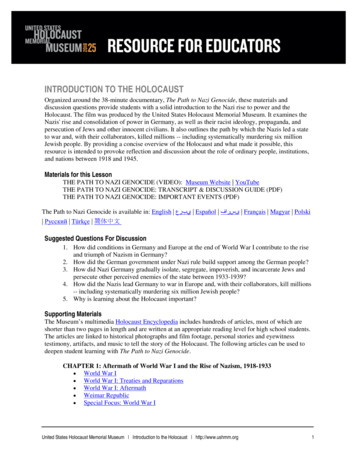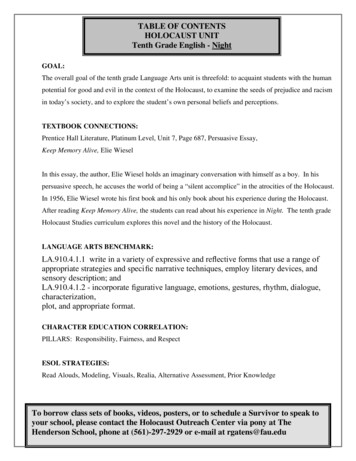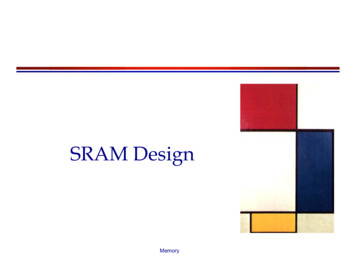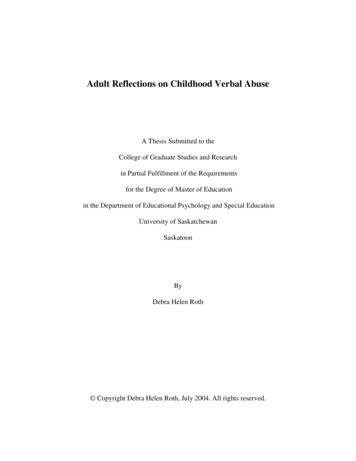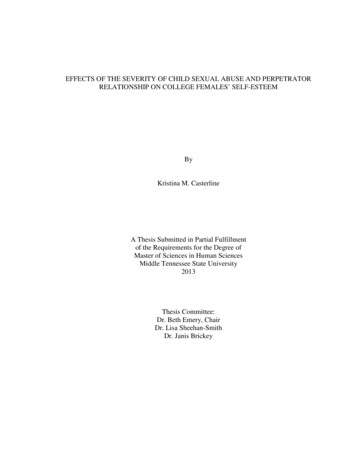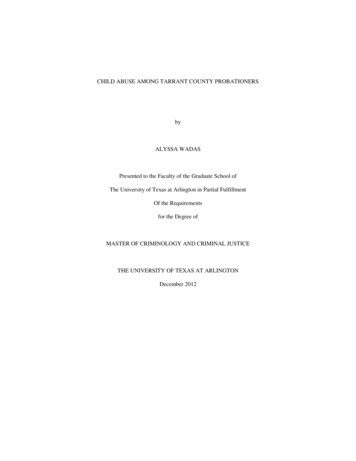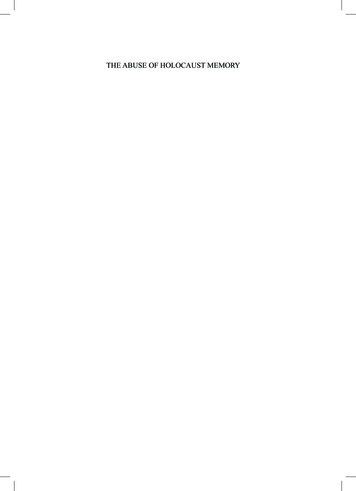
Transcription
THE ABUSE OF HOLOCAUST MEMORY
Books by the Same AuthorRevaluing Italy, with Lorenzo Necci (Italian), 1992Environment and Confusion: An Introduction to a Messy Subject, 1993Israel’s New Future: Interviews, 1994The State as a Business: Do-It-Yourself Political Forecasting (Italian), 1994Judaism, Environmentalism and the Environment, 1998The Environment in the Jewish Tradition: A Sustainable World (Hebrew), 2002Europe’s Crumbling Myths: The Post-Holocaust Origins of Today’s Anti-Semitism,2003American Jewry’s Challenge: Conversations Confronting the 21st Century,2004Israel and Europe: An Expanding Abyss? 2005European-Israeli Relations: Between Confusion and Change? 2006Books EditedThe New Clothes of European Anti-Semitism, with Shmuel Trigano (French),2004Academics against Israel and the Jews, 2007Israel at the Polls 2006, with Shmuel Sandler and Jonathan Rynhold, 2008Behind the Humanitarian Mask: The Nordic Countries, Israel and the Jews,2008MonographThe Autumn 2005 Riots in France: Their Possible Impact on Israel and the Jews,2006
THE ABUSE OF HOLOCAUST MEMORYDISTORTIONS AND RESPONSESManfred GerstenfeldJerusalem Center for Public AffairsInstitute for Global Jewish Affairs
Publication of this book was made possible in part by the support of theConference on Jewish Material Claims against Germany (Rabbi Israel MillerFund for Shoah Research, Documentation and Education) for the JCPA programon Contemporary Holocaust Distortion.Copyright 2009 by Jerusalem Center for Public Affairs (JCPA)and Manfred GerstenfeldAll rights reservedNo part of this book may be reproduced or transmitted in any form, or by anymeans, electronic or mechanical, including photocopying or recording, or byany information storage and retrieval system—except for brief quotations incritical articles or reviews—without written permission from the JCPA, 13 TelHai Street, Jerusalem, 92107, Israel. Tel: 972 2 561 9281, Fax: 972 2 5619112. E-mail: jcpa@netvision.net.il, www.jcpa.orgISBN: 978-965-218-076-6Set in New Times New Roman by Judith Sternberg, JerusalemPrinted at Ahva — Coop. Printing Press LtdCover design by Rami & Jacky
Dedicated to all those who fight the perpetratorsof Holocaust justification, inversion, denialand other abuses of Holocaust memory.
Table of ContentsAcknowledgments9Abraham H. Foxman: Foreword11Introduction15Chapter One: Categories of Distortion23Chapter Two: Holocaust Justification and Promotion33Chapter Three: Holocaust Denial47Chapter Four: Holocaust Deflection and Whitewashing60Chapter Five: Holocaust De-Judaization79Chapter Six: Holocaust Equivalence90Chapter Seven: Holocaust Inversion: The Portraying of Israel and Jewsas Nazis101Chapter Eight: Holocaust Trivialization116Chapter Nine: Obliterating Holocaust Memory129Chapter Ten: The Importance of Apologies136Chapter Eleven: What Can and Should Be Done?151ESSAYS AND INTERVIEWSManfred Gerstenfeld: Europe’s Distortion of the Meaning of the Shoah’sMemory and Its Consequences for the Jews and Israel, an interviewwith Shmuel Trigano175Mikael Tossavainen: The Holocaust in Arab Public Discourse:Historicized Politics and Politicized History184
Susanne Y. Urban: Representations of the Holocaust in Today’s Germany:Between Justification and Empathy196Manfred Gerstenfeld: The Destruction of the Memory of Jewish Presencein Eastern Europe; A Case Study: Former Yugoslavia, an interviewwith Ivan Ceresnjes207Dave Rich: The Holocaust as an Anti-Zionist and Antiimperialist Toolfor the British Left218Index231
AcknowledgmentsI would like to express my gratitude to the Jerusalem Center for Public Affairsand the Anti-Defamation League for publishing this book. Many thanks to IsiLeibler for his role in the agreement between the publishers.Thanks are also due to the authors and interviewees whose contributions arecontained in the second section of this book.I appreciate the support received for the activities of the Institute forGlobal Jewish Affairs and in particular its Post-Holocaust and Anti-Semitismprogram, from Dore Gold and Chaya Herskovic, president and director-general,respectively, of the JCPA. Many thanks are also due to Edna Weinstock-Gabay,who was responsible for the production of this book. Michael Salberg and PhyllisGerably at the ADL have been particularly helpful.I am grateful to Michael Bazyler, Alex Grobman, Peter Medding, RobertRosett, Michael Salberg, and Efraim Zuroff for sharing with me their views ona number of topics. I have greatly benefited from Mikael Tossavainen’s insightson a large number of issues. The participants in the JCPA’s Post-Holocaust andAnti-Semitism seminars have made a variety of valuable comments. Tamas Berzihas helped in many ways.I would like to thank researchers Debby Hartmann and Asaf Tal for theirdedication. A number of research students who interned at the JCPA havecontributed to this book by identifying and collecting sources. I am grateful toJessica Feldman, Rena Garshowitz, Clara Girard-London, Yonit Golub, RomyGrace, Miranda Jones, Miriam Mandl, and Elise Wiedre, and to those otherswhose contribution was incidental.Many thanks to Fredelle Ben-Avi for typing the multitude of drafts of thisbook, and to David Hornik for his copyediting and proofreading.Manfred Gerstenfeld9
Abraham H. FoxmanForewordIn this important addition to the body of knowledge and understanding of thedenial and distortions of the Holocaust, Manfred Gerstenfeld challenges usto examine why it is that as the world’s knowledge and understanding of theHolocaust continues to increase and become evermore accessible, the traditionalwell-known form of Holocaust denial — “it simply did not happen” — hasmorphed and metastasized into the various categories of abuse of historical facthe presents and analyzes in this unique volume.Having spent my entire professional life working at the Anti-DefamationLeague to combat the lies, myths, distortions, and half-truths used by those whoare filled with hate to demonize the ones they hate, I continue to be deeply troubledby the ease with which the truth about the greatest crime in history perpetratedagainst the Jews is ignored, overlooked, and twisted. Painful as this is for theremaining survivors and their children, if we do not confront it with all the toolsavailable to us, the six million Jewish victims of the Holocaust will perish asecond time. It is our duty to prevent this from happening, not just for the Jewishpeople, but for all of humankind for generations to come who will be deprived ofthe crucial lessons of the Holocaust.At a time when the president of Iran is the leading purveyor of Holocaustdenial, using it as a weapon in his arsenal of state-sponsored anti-Semitism aimedat demonizing Israel and the Jewish people, there is an ever greater need to betterand more fully grasp every aspect of this pernicious weapon. In an age where theInternet magnifies and propels around the globe expressions of hate of all kinds,Holocaust denial and other forms of anti-Semitism arrive in our homes uninvitedand unexplained at a breathtaking volume and speed. This is the most difficultchallenge in our effort to reverse the proliferation of hate-filled anti-Jewishsentiment. If the president of a country can spew Holocaust denial and is notconfronted and condemned quickly and clearly, the lie can take hold and the germof anti-Semitism can spread. The deeper our understanding of the latest variety ofthis centuries-old disease, the better equipped we are to meet the challenge. Thisbook arrives at a time when it is sorely needed.As Nobel Laureate Elie Wiesel has said, “not all victims of the Nazis wereJews, but all Jews were victims.” A simple and very sad corollary to Prof. Wiesel’sprofound observation is that only Jews are the target of the deniers of the Holocaust.And here is where we find the basic anti-Semitic roots of Holocaust denial.I have written about some of the aspects of Holocaust abuse and distortion11
12Forewordcovered in this book — historical revisionism, trivialization, universalization —and, in our ongoing battle against the scourge of anti-Semitism, the ADL dealsdaily with each of the types presented by Manfred Gerstenfeld. Just in the year2009 alone, from the Netherlands to Argentina, from France to Ukraine, fromRussia to Venezuela, from Germany, Lithuania, Switzerland, Belarus, Thailand,and my own country, the United States, we saw an explosion of comparisons ofIsrael’s actions to the behavior of the Nazis during the Holocaust and the use ofNazi imagery to describe Zionism.Manifestations of anti-Semitism have grown, fueled by intense anti-Israelisentiment. Nazi comparisons and anti-Semitic beliefs combine in a volatile mix,and this outpouring of anti-Jewish hate is generally met with little or no publiccondemnation. Chants of “Jews to the gas chambers” are heard routinely at antiIsraeli demonstrations in Europe and similar calls for death to Jews have beenheard across the Arab and Muslim world. Newspapers in the Arab world andLatin America have published pieces making blatant comparisons between Israeland the Nazis’ perpetration of the Holocaust. Caricatures that depict Israelisas Nazis are appearing daily in the Arab press, in Latin American, and even insome mainstream European newspapers. These comparisons and the imagery arereminiscent of the Nazis’ use of Der Stürmer to feed the age-old myths of Jews asa satanic and conniving force whose goal is world domination.Here are just a few examples of the manifestations of Holocaust abuse thatthe ADL noted in the first nine months of 2009:Voskresensk, Ukraine — Vandals defiled a Holocaust memorial. Swastikas andanti-Semitic graffiti, including “Death to Jews” in German and Russian,were painted on the monument.Bern, Switzerland — Anti-Israeli protesters carried signs equating Israel withNazi Germany.Petrozavodsk, Russia — A Holocaust memorial in a Jewish cemetery wasvandalized.Amsterdam, the Netherlands — At an anti-Israeli rally that included theparticipation of two Dutch legislators, part of the crowd chanted, “Hamas,Hamas, Jews to the gas.”Vezaiciai, Lithuania — A swastika and the Nazi slogan “Juden raus” were paintedon a sign commemorating a site where Nazis murdered Jews.Berlin, Germany — Berlin's Holocaust memorial was vandalized with antiSemitic slogans and swastikas.Drancy, France — A five-foot black swastika and several anti-Semitic sloganswere painted on a railway wagon that was used to deport French Jews. Twoother large swastikas were daubed on a commemorative monument and onthe wall of a nearby shop.Brest, Belarus — A Holocaust memorial was set on fire on the day commemoratedas Victory Day over the Nazis.
Abraham H. Foxman13In my lifetime of work combating anti-Semitism, hatred, and bigotry of all kinds,I have been committed to overcoming these stubborn ingrained ills of society firstby forthrightly identifying them and presenting the truth and then by activatingand enlisting the support of good people who respect the truth to join me in thestruggle against prejudice. In 2003, I wrote:Within living memory, we’ve seen what can happen when a nation or acontinent experiences an unrestrained outbreak of anti-Semitism. The Jewsof the world – and all people of goodwill who share their desire for a just andfree society – learned a series of critical lessons from the tragic history of thetwentieth century. Today we understand how important it is to recognize theemergence of new forms of anti-Semitism so that we can warn the world andstave off the worst effects.If we are to succeed in overcoming the atmosphere of permissiveness that hasmade it so much easier to diminish the meaning and lessons of the Holocaust, wemust be able to clearly describe the phenomena of Holocaust denial, distortion,and abuse we face daily. As leaders in the fight against anti-Semitism, the ADLrecognizes the need to have the best means possible to achieve that success. Weare grateful to Manfred Gerstenfeld for providing a significant new tool to helpus reach our goal.
IntroductionThe awareness of the Holocaust in the Western world has greatly increased sinceWorld War II. Leon Jick wrote that “in the years immediately following the endof the Second World War, consideration of the destruction of European Jewry wasnot merely avoided, it was repressed.”1Michael Berenbaum, executive editor of the new edition of the EncyclopediaJudaica, illustrated one aspect of this when speaking about Holocaust studiesmore than twenty-five years after World War II: “This field was in its infancyin the 1970s and was then taught in two American universities only. When thehistorian Raul Hilberg did his doctorate in the 1950s, his professor said that hecould go ahead but it would be his academic funeral. Indeed he could only finda publisher for The Destruction of the European Jews in 1961, if its publicationwas subsidized.”2The historian Peter Novick concluded that Hilberg’s book and the politicaltheorist Hannah Arendt’s Eichmann in Jerusalem caused a lot of debate andinterest in the Holocaust in the US, but that it was not a lasting trend.3Since the 1980s, the Holocaust has gradually become a more central elementof collective memory in many countries.4 This is particularly the case in Germany,the countries that were its wartime allies, as well as those that were occupied byit.At the same time, collective memory in the Western world has to a largeextent fragmented. There are fewer and fewer issues of the past that a majorityof people in many countries know about at least in some detail. Increasingsecularization is one reason for this decline in common memorial heritage. Inmany places there is no longer a widespread familiarity with the Bible. Christianvalue-concepts have also been diluted and no longer serve as a common bond inmany Western nations.In this growing historical vacuum where other elements of collective memoryhave faded away, the importance of the Holocaust has increased. The twentiethcentury mass murder of the Jews stands out as a major historical event that manypeople have heard about in differing degrees. This is also true in the United States,which fought the Germans overseas and where religion occupies a greater placein society than in many European countries.One of the many indicators of this is the large number of visitors — mostlynon-Jews — to the United States Holocaust Memorial Museum in Washington,DC.5 Another such indicator was the large number of heads of state whoparticipated in the Stockholm International Forum on the Holocaust in 2000.The extreme criminal character of the Holocaust and its many facets lendthemselves well to metaphorical use; the more so as society requires a real or15
16Introductionimagined metaphor of absolute evil. An example of the latter in the Christianworld was for a long time the Antichrist. Extreme racist nationalists invented theUntermensch, people of a subhuman race.Aspects of the Holocaust are often correctly cited and accurately utilized. Thewider familiarity with the subject, however, also makes it prone to a multitude ofdistortions. Its history and terminology are manipulated for a variety of purposes.This includes the abuse of elements of the Holocaust as a tool against one’senemies, and in particular Jews and Israel. Other Holocaust falsifications derivefrom a variety of motivations.Information on and illustrations of the abuse of Holocaust memory could fillan encyclopedia. There is enough material for books about specific topics — forinstance, Holocaust deflection, whitewashing, or equivalence. Concerning the meansof counteracting abuses, a number of subjects also merit treatment in a book. One isthe issue of apologies by the successors of governments, parliaments, institutions,and corporations that were perpetrators or bystanders during the Holocaust.The material in this book can also be used for several other types of analysis.The nature of the abuses, their motivations, and the reactions to them provideprisms into various aspects of contemporary society. One of these is the betterunderstanding of the broader issue of mutations in perceptions of the past.6 Forthis the changes not only of Holocaust memory, but also of its abuses over time,could serve as a paradigm.Categories of AbuseHence, in this volume a strategic approach to the many issues at stake had to betaken. Holocaust distortions are grouped into eight categories. To better clarifythese manipulations, they have frequently been illustrated with vignettes. Theamount of information on some subjects, however, is so large that only a verysmall selection of examples could be included.The analysis hereinafter also includes cases that, in the strict sense, arenot abuses of the Holocaust but rather manipulations based on other elementsof Germany’s Nazi past. One example of this type of distortion is comparingpersons with Hitler or other German leaders.Recent EventsHolocaust-memory-related events and distortions that occurred in the twelvemonths before the publication of this book reveal how the memory of the genocidehas become an instrument for many purposes, and also an indicator of both valuesand their degradation in various societies. These are two of the many roles thataspects of the Holocaust fulfill in Western and sometimes also other societies.
Manfred Gerstenfeld17A listing of some Holocaust-related issues that were picked up by theinternational media shows their great variety. In September 2008, the genocidepromoting Iranian president Mahmoud Ahmadinejad once more addressed theUnited Nations General Assembly. He again made anti-Semitic remarks and drewsome applause from delegates.7 In November, there were ceremonies to mark thelapse of seventy years since Kristallnacht. In many of these it was mentioned howthis event was an indicator of developments to come in Hitler’s Germany.During Israel’s Gaza campaign in late December 2008 and January 2009,there were many anti-Israeli demonstrations. In some of them, calls were heardfor the extinction of Israel and the murder of the Jews. These were often made byMuslims. In a number of gatherings in Western cities, signs were carried equatingJews with the Nazis and the Star of David with the swastika.8On 27 January 2009, the United Nations held its annual ceremony forInternational Holocaust Remembrance Day. General Assembly presidentMiguel d’Escoco Brockmann of Nicaragua skipped the event. He had huggedAhmadinejad at the UN plenary and had often made virulent anti-Israelistatements. He inverted the Holocaust when he described the situation in Gaza as“genocide.”9 Various Jewish organizations had come out against his participation.A press release of the Anti-Defamation League (ADL) was titled: “GeneralAssembly President Unfit to Participate in U.N. Holocaust Ceremony.”10Bishop Williamson, Durban 2In February, Pope Benedict XVI lifted the excommunication of four bishops of thefundamentalist Society of St. Pius X. One of these, Bishop Richard Williamson,is an outspoken Holocaust denier. Jewish organizations protested against thisstep. The canceling of Williamson’s excommunication led to an internationaldebate that included strong criticism of the pope, from both Catholics and othergentiles.The Durban 2 review conference took place in Geneva in April 2009. It wassupposed to deal with the battle against racism. Ahmadinejad, the world’s leadinginciter to genocide, was one of its most prominent speakers. Before the conferencethis Holocaust denier was received by Swiss president Hans-Rudolf Merz.The conference also illustrated another development: increasingly, extremepositions of current Holocaust abusers are whitewashed in various ways. Oneexample was when Ahmadinejad spoke at the Geneva conference and the Vaticanrepresentative remained in the room. The reason given was that the Iranianpresident left out a sentence from his draft speech about Holocaust denial.What remained of the text should have been more than sufficient for the Vaticandiplomat to walk out.11The United States, Canada, and several European countries did not attendthe conference; the delegations of all other European Union states as well as
18Introductionsome others, walked out when Ahmadinejad spoke. The Swiss and Norwegians,however, were among those who stayed.12 Norwegian foreign minister Jonas GahrStøre criticized Ahmadinejad in his speech in the plenary. Many other delegateswho remained in the hall applauded the man who, more than any other worldleader, espouses the call for the mass murder of Jews.The Pope, Facebook, DemjanjukIn the debate around the visit of Pope Benedict XVI to Jordan, Israel, and thePalestinian Authority in May, much attention centered on his attitude toward theHolocaust. In connection to the visit, the Vatican first denied that the pope hadever been a member of the Hitler Youth but a few hours later said he had beenforced to join the movement. This had been known for a long time.13Many other recent events drew international attention to Holocaust issuesand Holocaust distortion. Suspected Nazi death-camp guard John Demjanjukwas taken into custody in Germany in May 2009 after he was deported from theUnited States.14 When German doctors decided in July 2009 that Demjanjuk wasfit to stand trial, this again received much international media attention.15A variety of media also reported on various Holocaust-denial groups onFacebook. The site managers refused to ban these groups unless they were basedin a country where such denial is a criminal offense.16The Holocaust was also a topic in a much-discussed speech by U.S. presidentBarack Obama in Cairo in June. Some of his remarks were misleading.17Thereafter the president went to Germany where he visited the concentrationcamp Buchenwald together with German chancellor Angela Merkel and ElieWiesel.18In the same month a white supremacist shot a security guard at the U.S.Holocaust Memorial Museum in Washington. This incident drew far moreinternational attention than if a guard of any other American museum had beenshot. Obama stated that the killing had saddened him.19Also in June attention was given to the fact that Anne Frank, had she lived,would have been eighty years old. She was remembered on this occasion in manyplaces around the world, some far-flung. One of these was Wayanad in the Indianprovince of Kerala. There a number of activities for youth aged fifteen to eighteenwere planned in her memory.20At the end of June, almost fifty countries participated in the PragueConference, which urged governments to increase the care of Holocaustsurvivors. The conference also called for the return of or compensation for privateproperty taken from Jews during the Holocaust. Poland, which participated inthe gathering, was seen as the major offender on this issue as it has no privateproperty restitution laws.21 This conference was mentioned in hundreds of mediastories around the world.
Manfred Gerstenfeld19In July, Bernie Ecclestone, a billionaire who holds part of the rights to thepromotion of Formula One automobile racing, said that dictators like Adolf Hitler“got things done.” After much criticism Ecclestone withdrew his words and said,“I’m just sorry I was an idiot. I sincerely genuinely apologize.”22The international references to the Holocaust and the Nazi period areextremely disparate. In July, for instance, German prosecutors launched aninquiry into whether an artist who had produced garden gnomes, raising theirarms in a Hitler salute, and the Nuremberg gallery that exhibited them, werebreaking the law.23The next Holocaust-related item that drew some international attentionwas the burning down of the barracks where Anne Frank had worked in theDutch transit camp Westerbork. The barracks had been used for decades as anagricultural warehouse but was soon to be reconstructed at the camp’s memorialsite. Anne Frank was deported from Westerbork to the east. She later died in theGerman concentration camp Bergen-Belsen.24A few days later attention was drawn to the mayor of the Romanian cityConstanta, who was seen goose-stepping with his son in German army uniformsduring a weekend fashion show. He was quoted as saying, “I wanted to dress likea Wehrmacht general because I’ve always liked this uniform, and admired therigorous organization of the German army.”25At the end of the month, the American Jewish Committee in Berlin filed acomplaint against the German Amazon site. It asked prosecutors to investigatewhether the site had broken German laws against Holocaust denial by sellingbooks with far-Right content. Holocaust denial is a crime in Germany that canlead to punishment of several years in prison.26At the beginning of August, the American talk-show host Rush Limbaughwrote: “Obama’s got a health care logo that’s right out of Hitler’s playbook.” Hewent on to make a whole list of similarities between the Democratic Party and theNazi Party in Germany. This drew attention from a variety of mainstream papers.27Abraham Foxman, national director of the ADL, asserted, “Regardless ofthe political differences and the substantive differences in the debate over healthcare, the use of Nazi symbolism is outrageous, offensive and inappropriate .Americans should be able to disagree on the issues without coloring it with Naziimagery and comparisons to Hitler.”28A few days later the Central Council of Jews in Germany, the roof organizationof German Jewry, said it wanted Germany to lift the ban on publishing Hitler’sbook Mein Kampf. The group’s secretary-general Stephan J. Kramer stated that anew scholarly edition of the book should contain comments that would educatefuture generations on the evils of Nazism.29Although the Holocaust keeps regularly coming to the fore of the internationalmedia, there is simultaneously a certain Holocaust fatigue in parts of Westernsociety. Many people do not want to be reminded of what happened and nowseems long ago. Yet the past several months prove again that ongoing events
20Introductionmake mentioning the memory of the Holocaust — be it true or false — almostunavoidable and likely to remain so.A Second Holocaust?The debate about whether the Holocaust can happen again has been wagedfor decades at differing levels of intensity, mainly among Jewish communitiesbut also elsewhere. This discussion about a possible Second Holocaust againdeveloped in the United States during the major outburst of anti-Semitism —only in part disguised as anti-Israelism — in the new century. In April 2002,American columnist Ron Rosenbaum stated that the “second Holocaust” was aphrase coined by Philip Roth in his 1993 novel Operation Shylock. Rosenbaumclaimed it was likely — rather than novelistic — that sooner or later a nuclearweapon would be detonated by Arab fundamentalists in Tel Aviv.30The writer Leon Wieseltier reacted to this and similar pessimistic articlesby saying that the Jews had found both safety and strength. He concluded: “TheJewish genius for worry has served the Jews well, but Hitler is dead.”31 Rosenbaumcountered by claiming Wieseltier was fleeing into denial as there were manyHitler-like examples of demonization of the Jews in the Arab world. He referredto Palestinian justification of the Holocaust, the denial of the Holocaust by anEgyptian government paper while supporting Hitler if he had indeed exterminatedthe Jews, and a Saudi government broadcast of a cleric calling for the annihilationof the Jews.32The genocidal remarks by Ahmadinejad have, however, stimulated thedebate on the possibility of a Second Holocaust, which has increasingly becomethe subject of speculation.The sociologist Zygmunt Baumann has offered another perspective linkingthe Holocaust to structural elements of modern society. He states that the Holocaustwas a product of men who were educated in the most refined culture of Westernsociety. It was thus a product of Western society and civilization. Since nothingfundamental has changed in Western societies, the study of the Holocaust is ofmore than academic interest. In Bauman’s view, even though another Holocaustmay not occur, the infrastructure and mechanisms for a similar event are still inplace.33The Holocaust and Public DiscourseThe Holocaust will continue to play an important role in public discourse for along time to come. The following analysis of the main categories of Holocaustdistortion can help identify and interpret such manipulations. This may alsofacilitate responses against them.
Manfred Gerstenfeld21The various reactions to such distortions also serve as an indicator of themood of societies. Examples are the ways in which the Western world respondedto Ahmadinejad’s genocidal pronouncements.34 The names of those in the Westernworld who have met with Ahmadinejad should be retained for the future. Theycan be confronted with their misbehavior, for instance, when they make publicstatements. The Mennonite Central Committee was among those particularlyactive in organizing meetings and events with Ahmadinejad.35 Among theattendants were many prominent representatives of American churches.We live in times of major flux and uncertainty. In such periods it is particularlyimportant to document events. In this way the identity of the hate-mongers anddistorters of Holocaust history will be preserved. This may help in the battleagainst future such distorters.In reading this book, it will emerge how numerous are the abuses of Holocaustmemory. With no detailed analysis available of many of the phenomena exposed,one cannot quantify their relative importance. The emphasis must be laid onqualitatively exposing as many aspects as possible instead of in-depth analysisof a few of them.Notes1.2.3.4.5.6.Leon A. Jick, “‘Method in Madness’: An Examination of the Motivations for Nazi MassMurder,” Modern Judaism, Vol. 18, No. 2 (May 1998): 153–172.Manfred Gerstenfeld, “The Transformation of Jewish Knowledge over the Decades:The New Edition of the Encyclopedia Judaica,” an in
book, and to David Hornik for his copyediting and proofreading. Manfred Gerstenfeld. 11 Abraham H. Foxman Foreword In this important addition to the body of knowledge and understanding of the denial and distortions of the Holocaust, Manfred Gerstenfeld challenges us to examine why it is that as the world's knowledge and understanding of the Holocaust continues to increase and become evermore .



